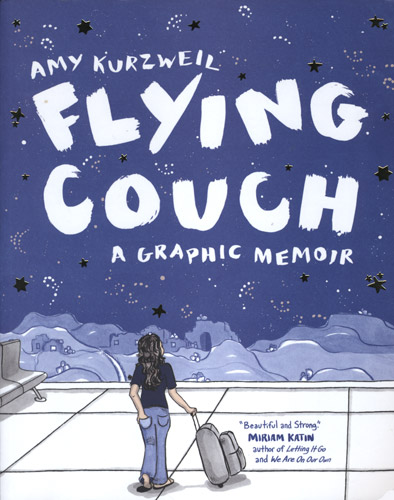Flying Couch
The holiday season brings families together, for better or worse, leading many of us to face the makeup of our identities across the dining room table. Whether it’s seeing your own mannerisms in your parents, or it’s basking in grandparents’ old stories from before you were born, we can recognize the ways in which our families have shaped our identities. In her graphic memoir, Flying Couch, Amy Kurzweil explores her own identity as a granddaughter, a daughter, an artist, and a Jew.
The holiday season brings families together, for better or worse, leading many of us to face the makeup of our identities across the dining room table. Whether it’s seeing your own mannerisms in your parents, or it’s basking in grandparents’ old stories from before you were born, we can recognize the ways in which our families have shaped our identities. In her graphic memoir, Flying Couch, Amy Kurzweil explores her own identity as a granddaughter, a daughter, an artist, and a Jew.
Kurzweil doesn’t take on this task unarmed, however. Bubbe, Kurzweil’s grandmother, lends the use of her own written survival story which details the ways Bubbe stayed alive as a Jew during WWII. What is first presented as a silly quirk that Kurzweil and her mother joke about, Bubbe’s scavenging of recyclables in the park suddenly makes much more sense: when one scavenges to survive, it’s hard to break the habit, even years later. Kurzweil weaves her grandmother’s story throughout her own, demonstrating the ways in which the pasts of our family members are woven into our own presents whether we’re aware of it or not.
Kurzweil’s mother also makes appearances. A psychologist, her mother is often presented as an opposite to Kurzweil: she’s self-assured and orderly, her background in psychology lending an almost frustrating levelheadedness to her words and actions.
But just because Kurzweil is not alone in penning her story, does not mean she’s sure of her identity either. In fact, in the shadow of her matriarchs, she’s left with more doubt than enlightenment, leading her to travel first to Israel and then to Heidelberg as she explores the past and present of her Jewish ancestry. This doesn’t solve her confusion, but it does lead Kurzweil to introspective moments as she considers family, home, and the roots of our family trees, even as she battles the trip’s frivolities of drinking wine and meeting cute boys.
There’s one final identity Kurzweil holds that she examines in her graphic memoir, which is that of an artist. Even this is looked at through the eye of her family. Bubbe loves the idea of her story being brought to a larger audience, while Kurzweil’s mother requests that she be depicted as “Sexier. I mean, more dynamic. I’m not just a therapist, you know.” Showing her family’s commentary on Flying Couch’s manuscript continues to demonstrate the ways our families influence us, and the ways we define ourselves while in their company.
During the span of Flying Couch, Amy Kurzweil never conclusively defines who she is as an artist, a daughter, a granddaughter, or a Jew, but leaves readers in a place where we can believe she’ll be just fine anyway.





